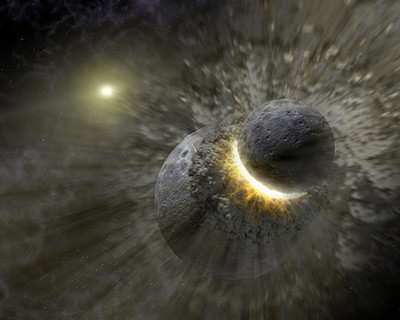When Worlds Collide
Astronomers say a dusty disc swirling around the nearby star
Vega is bigger than earlier thought. It was probably caused by
collisions of objects, perhaps as big as the planet Pluto, up to
2,000 kilometers (about 1,200 miles) in diameter.
NASA's Spitzer Space Telescope has seen the dusty aftermath of
this "run-in." Astronomers think embryonic planets smashed
together, shattered into pieces and repeatedly crashed into other
fragments to create ever-finer debris. Vega's light heats the
debris, and Spitzer's infrared telescope detects the radiation.
Vega, located 25 light-years away in the constellation Lyra, is
the fifth brightest star in the night sky. It is 60 times brighter
than our Sun. Observations of Vega in 1984, with the Infrared
Astronomical Satellite, provided the first evidence for dust
particles around a typical star. Because of Vega's proximity and
because its pole faces Earth, it provides a great opportunity for
detailed study of the dust cloud around it.

"Vega's debris disc is another piece of evidence demonstrating
the evolution of planetary systems is a pretty chaotic process,"
said the lead author of the study, Dr. Kate Su of the University of
Arizona, Tucson, AZ. The findings were presented today at the 205th
meeting of the American Astronomical Society in San Diego.
Like a drop of ink spreading out in a glass of water, the
particles in Vega's dust cloud don't stay close to the star long.
"The dust we are seeing in the Spitzer images is being blown out by
intense light from the star," Su said. "We are witnessing the
aftermath of a relatively recent collision, probably within the
last million years."
Scientists say this disc event is short-lived. The majority of
the detected material is only a few microns in size, 100 times
smaller than a grain of Earth sand. These tiny dust grains leave
the system and dissipate into interstellar space on a time scale
less than 1,000 years. "But there are so many tiny grains," Su
said. "They add up to a total mass equal to one third of the weight
of our moon."
The mass of these short-lived grains implies a high
dust-production rate. The Vega disc would have to have an
improbably massive reservoir of planet-building material and
collisions to maintain this amount of dust production throughout
the star's life (350 million years, 13 times younger than our Sun).
"We think a transient disc phenomenon is more likely," Su said.

Su and her colleagues were struck by other characteristics of
Vega's debris disc, including its physical size. It has a radius of
at least 815 astronomical units, roughly 20 times larger than our
solar system. One astronomical unit is the distance from Earth to
the Sun, which is 150 million kilometers (93 million miles). A
study of the disc's surface brightness indicates the presence of an
inner hole at a radius of 86 astronomical units (twice the distance
between Pluto and the Sun). Large embryonic planets at the edge of
this inner hole may have collided to make the rest of the debris
around Vega.
"Spitzer has obtained the first high spatial-resolution infrared
images of Vega's disc," said Dr. Michael Werner, co-author and
project scientist for Spitzer at NASA's Jet Propulsion Laboratory,
Pasadena, CA. "Its sensitive infrared detectors have allowed us to
see that Vega is surrounded by an enormous disc of debris."
JPL manages the Spitzer Space Telescope mission for NASA's
Science Mission Directorate, Washington. Science operations are
conducted at the Spitzer Science Center at the California Institute
of Technology in Pasadena. JPL is a division of Caltech. The
multi-band imaging photometer for Spitzer, which made the new disc
observations, was built by Ball Aerospace Corporation, Boulder, CO;
the University of Arizona; and Boeing North American, Canoga Park,
CA.
 SpaceX to Launch Inversion RAY Reentry Vehicle in Fall
SpaceX to Launch Inversion RAY Reentry Vehicle in Fall Aero-News: Quote of the Day (04.23.24)
Aero-News: Quote of the Day (04.23.24) Aero-News: Quote of the Day (04.20.24)
Aero-News: Quote of the Day (04.20.24) ANN's Daily Aero-Linx (04.20.24)
ANN's Daily Aero-Linx (04.20.24) Aero-News: Quote of the Day (04.21.24)
Aero-News: Quote of the Day (04.21.24)




